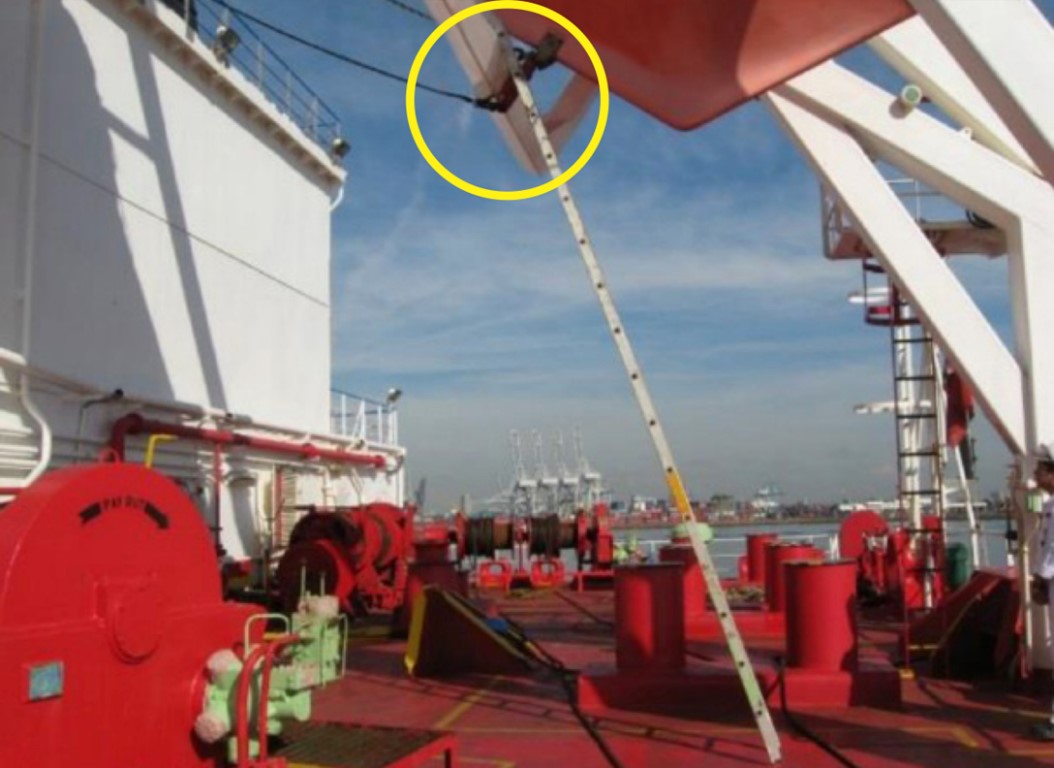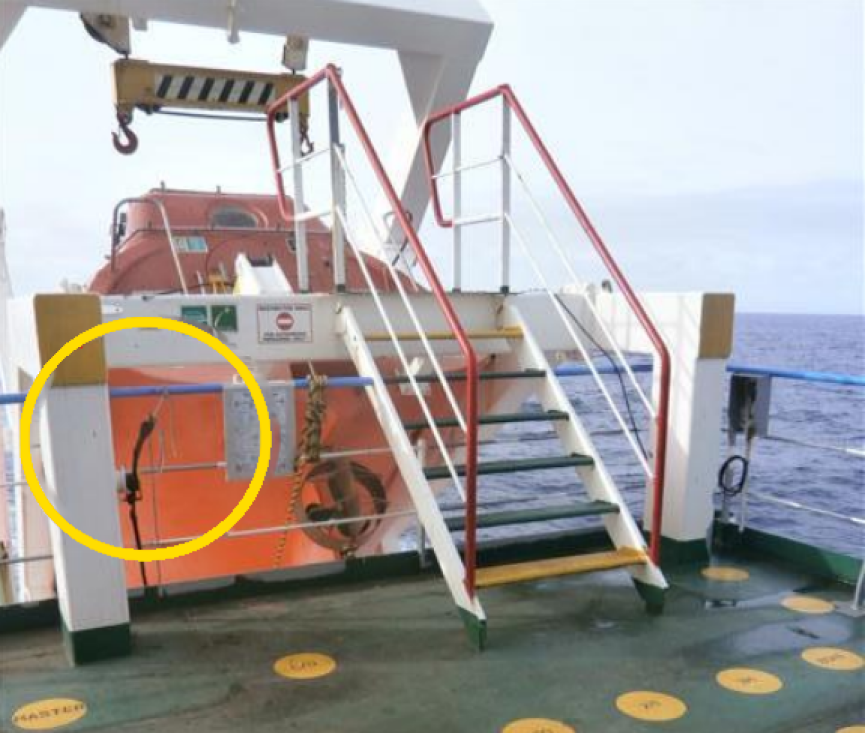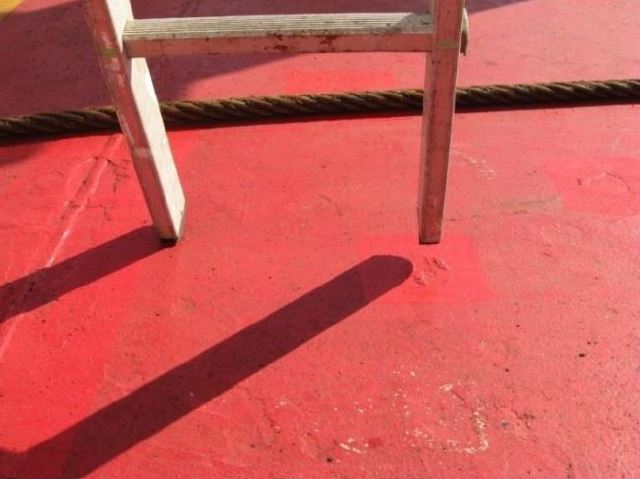An AB on board a product tanker suffered severe injuries after falling from a portable ladder (Figure 1) while conducting maintenance work on the launching system for the ship’s free-fall lifeboat and later tragically died from his injuries.

WHAT HAPPENED?
A product tanker was on route from South Korea to Los Angeles. While at sea, as the crew was preparing for an announced USCG inspection to take place while alongside in Los Angeles, it was found that a lashing turnbuckle for the ship’s free-fall lifeboat was defect due to corrosion, as the securing pin was seized.
The chief officer informed both the bosun and the AB about the work and instructed that it should only involve the removal of the remaining rust and painting of the turnbuckle. The bosun was also told that the AB was to assist the rest of the deck crew in cleaning activities once the task was completed.
No work permit was issued as the work was planned to take place at a height of about one metre above deck and in an area fitted with railings (Figure 2).
THE CHIEF OFFICER CARRIED OUT A VERBAL RISK ASSESSMENT OF THE MAINTENANCE JOB TOGETHER WITH THE TWO BOSUNS ON BOARD, AND ADVISED THAT DUE TO THE SHIP ROLLING MODERATELY NO WORKING ALOFT WOULD BE ALLOWED.

While performing the job, the AB observed that the forward hook on the davit of the free-fall lifeboat needed lubrication. Having finished the work on the turnbuckle, he approached the bosun and asked him to assist him with lubricating the forward hook by steadying a ladder he had positioned on deck below the lifeboat forward hook (Figure 1). The height from the deck to the hook was about 4.8 metres. The ladder was equipped with rubber feet at the bottom of each leg.
HOWEVER, THE FEET WERE SIGNIFICANTLY WORN AND WERE NOT BOTH IN FIRM CONTACT WITH THE DECK (FIGURE 3). DESPITE THE LADDER BEING UNSTABLE, IT WAS NOT SECURED BY ANY OTHER MEANS.

The AB climbed up the ladder, reportedly not wearing any PPE. The bosun tried to stop him, but he nonetheless continued to assist by holding the ladder while the AB ascended. Having climbed part of the way up, the ladder suddenly slipped. The bosun was not able to hold the ladder so the AB fell and ending up lying unconscious on the deck.
The chief officer was informed and a stretcher was brought to the incident site and the AB was transferred to the ship’s hospital. The master contacted CIRM Roma for medical advice and later also the ship’s agent requesting possible assistance from the USCG to carry out a medevac. However, the agent confirmed that a helicopter would not be able reach the ship for several hours.
Two and a half hours after the incident the AB stopped breathing. Although defibrillation was initiated, this was sadly unsuccessful and half an hour later the AB was pronounced dead on board.
Further details about the incident and the lessons learned are provided in the summary of the case study.
In addition, a presentation and reflective learning form have been prepared based on the incident as suggested training materials. These can be used by Members or their crew in any way they see fit to encourage reflection and gain the maximum learning from this incident: to consider why the incident happened; “what it means to me”, and to then relate the identified learning points to one’s own personal situation.
Finally, a Britannia commentary on the incident has been prepared which discusses the key points in more detail in order to help develop the reflective learning from the case study.
CASE STUDY MATERIAL
BSAFE INCIDENT CASE STUDY NO.2 – SUMMARY
BSAFE INCIDENT CASE STUDY NO.2 – REFLECTIVE LEARNING FORM
LESSONS LEARNED
The following lessons learned have been identified based on the information available in the investigation report and are not intended to apportion blame on the individuals or company involved:
- No risk assessment and work permit was completed prior to the work starting though this is required by the company’s Safety Management System (SMS) when working aloft. Therefore, the obvious risks of the tasks were not correctly assessed and mitigated.
- It is assumed that both the AB and the bosun were well aware of the SMS requirements, but it has not been possible to determine the reasons why the requirements were not followed. In addition the bosun had been told by the chief officer that no work was to be carried out at height.
- The portable ladder was not appropriate for the task being undertaken. It was in poor condition and both feet were not in contact with the deck. Furthermore, the ladder was not safely secured which likely contributed to it being unstable and slipping.
- If the AB had used proper PPE to climb the ladder, this would have afforded him some protection when he fell and may have reduced the severity of his injuries.
- The accident would have been prevented if the bosun had stopped the job rather than assisting the AB by attempting to steady the ladder.
This case study is drawn from the investigation report 04/2017 published by the Norwegian Safety Investigation Authority (formerly known as the Accident Investigation Board Norway – AIBN.
The purpose of this case study is to support and encourage reflective learning. The details of the case study may be based on, but not necessarily identical to, facts relating to an actual incident. Any lessons learned or comments are not intended to apportion blame on the individuals or company involved. Any suggested practices may not necessarily be the only way of addressing the lessons learned, and should always be subject to the requirements of any applicable international or national regulations, as well as a company’s own procedures and policies.

 English
English
